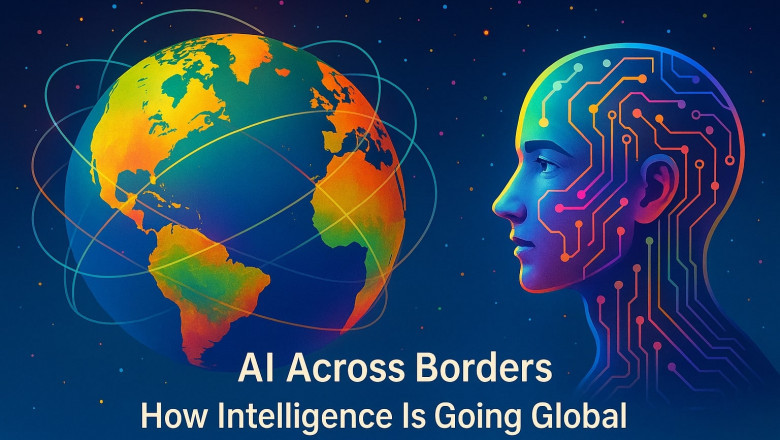views
Artificial intelligence is spreading fast. It’s changing how businesses work, how governments make decisions, and how people solve tough problems. This rapid growth shows no signs of slowing down. Companies and countries now see AI as a key tool for future success. But understanding how AI crosses borders is vital. It helps us see the bigger picture of what’s happening worldwide. In a digital world, AI research, applications, and rules are becoming more connected than ever.
The Evolution of AI as a Global Phenomenon
The Rise of International AI Research Collaboration
The Spread of AI Technologies Across Borders
AI isn’t just developed in one place; it’s adopted worldwide. Regions customize solutions to fit local needs. For example, Asian countries use AI in healthcare to better diagnose diseases. In Europe, self-driving cars are becoming more common. The growth of global internet infrastructure and data sharing has made this possible. Cross-border cooperation helps AI reach more people and industries.
Influential Policy Frameworks and Regulations
Governments are creating rules to guide AI’s growth. The EU AI Act aims to set clear standards in Europe. Meanwhile, the U.S. pushes for a more open, innovation-friendly approach. But making rules fit different countries isn’t easy. Countries have diverse laws and values that influence AI regulation. International groups like the United Nations and OECD are working to set shared rules. Their goal? Balance innovation with safety and ethics.
Cross-Border Data Flow and Its Impact on AI Development
Data Localization vs. Data Globalization
Countries want control over their data, called data sovereignty. Some enforce laws that keep data within borders. This can slow down AI progress because big models need large, diverse datasets. Other countries encourage global data sharing to make AI smarter. Data flows across borders, fueling better models and more accurate insights. The challenge? Working out how to share data safely while respecting privacy.
International Data Partnerships and Alliances
Multinational alliances allow countries and companies to exchange data securely. Examples include AI corridors that connect regions for data sharing. These partnerships help create larger, better datasets. At the same time, organizations work hard to protect privacy and prevent data misuse. Successful projects prove that teaming up across borders boosts AI innovation without risking security.
Ethical and Legal Challenges in Cross-Border Data Use
Sharing data internationally brings issues like consent and bias. Different countries have different laws about privacy. It’s vital to develop transnational legal frameworks that respect these differences. Organizations should also follow best practices, like anonymizing data and getting clear consent. This careful approach helps avoid legal trouble and builds trust with users.
AI’s Role in Global Economic Development
Driving Innovation and Economic Growth
AI is helping emerging economies grow faster. In Africa, AI improves farming methods, boosting food production. Southeast Asian countries use AI to modernize factories and create jobs. Studies show AI contributes to GDP growth by making industries more efficient. It’s also helping create new jobs in tech and data analysis.
Addressing Global Challenges Through AI
AI is a big tool in fighting climate change and health emergencies. It predicts natural disasters and detects diseases early. During global crises like pandemics, AI helps with diagnosis and treatment plans. Countries work together to develop AI solutions that benefit everyone. This collaboration makes tackling big issues more effective.
Challenges and Risks of AI Globalization
Relying too much on AI from a few tech giants might cause problems. It could deepen inequality if poorer countries can’t access technology. Dependence on one system could also be risky if it fails. To avoid this, nations need to build their own AI skills and share knowledge freely. Inclusive efforts ensure all countries can benefit from AI’s progress.
The Future of AI Borders: Opportunities and Obstacles
Emerging Trends in Global AI Governance
Expect to see more international talks about AI rules. Countries and companies are working toward common standards and treaties. Leaders want ways to ensure AI is safe and fair worldwide. Experts predict that stronger global cooperation will help avoid conflicts and misuse.
Innovation Hubs and Cross-Border Tech Ecosystems
Global hubs like Berlin, Shenzhen, and Toronto are fueling AI progress. They attract talent from all over the world. This mix of skills drives new ideas and faster development. International talent exchange programs help spread expertise and create a more connected AI community.
Overcoming Barriers to Global AI Integration
Interoperability and standardization are technical hurdles. Countries also face political issues related to sovereignty and control. To overcome these, organizations should build strong international partnerships. Participating in policy discussions and adopting open standards can open doors. Making AI systems compatible and ethical can help everyone move forward together.
Conclusion
AI is quickly becoming a global force. Its development relies on international teamwork, shared rules, and responsible use. We need open collaboration, thoughtful regulation, and ethical practices to shape AI’s future. When countries work together, AI can serve everyone’s best interests. The goal? Build an AI world that’s fair, inclusive, and safe for all. By understanding these cross-border dynamics, we can help guide the technology toward a better tomorrow.
For more, visit our site, Qurilo Solutions, the best software development company in India.






















Comments
0 comment